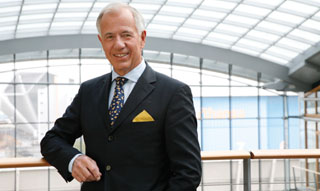By: Juergen Weber |
|  |
|---|
Stability and control are the essence of safe flying and succeeding as a business. On average, the airline industry is confronted with the challenge of new innovative cycles every 10 to 20 years. Keeping the craft on course and in trim and finding the right power-setting to master any potential rough ride is a task requiring entrepreneurial initiative, a sense of proportion and adaptive skills. How has Lufthansa managed to build a true airline group that finds itself well-positioned on the industry's leaderboard today?
Airline deregulation and its European variant of liberalisation led to a particularly dramatic cyclical change for all players at the time they were introduced. In the beginning, many airlines quarrelled and resisted change; only a few were bold and jumped in at the deep end.
CHANGING DIMENSIONS
Hesitant at first, Lufthansa decided to fully commit itself to a regulatory change that abandoned the old trading regime and fuelled competition. We made this decision at the start of the nineties - a time when the company was in its deepest crisis, almost bankrupt and where old certitudes had vanished into thin air. The need to restructure was fundamental and involved a mental change on the part of management and staff, as well as a new strategic alignment. The core strategy was to break up the formerly monolithic block of the company and give the individual business areas, such as the passenger business, cargo, maintenance and overhaul, catering, IT and tourism greater freedom of action and legal independence. This became the primer for what we subsequently named the Lufthansa Aviation Group of Companies.
The strategic consideration behind the decision was to have smaller, more flexible units that were closer to their markets and their customers, free to choose co-operative partners and achieve transparency in terms of revenue and expenditure. Their formation had to be seen against the background of a dramatically changed business environment, driven by globalisation, liberalisation and the rapid spreading of new IT tools, such as the internet and e-trading. Borders disappeared as a consequence of the breaking up of the old political blocs. People were treading in unknown territory and were eager to discover new spheres. This changed travel demands and patterns of both business and leisure travellers in a fundamental way.
But the world of aviation wasn't prepared for the changes in its own marketplace: individual airline networks did not have truly global reach; the regulatory framework was fragmented and complex because of a host of strict bilateral regimes and hardly any carrier had the resources to mount global operations that would penetrate deep into many of the world's regions. Most of these obstacles still exist. And I can't see them going away that quickly.
STAR ALLIANCE
To overcome these obstacles and achieve unrestricted travel in a world full of restrictions, visionary airlines were looking for strategic partnerships. Together, with four other far-sighted carriers, Lufthansa founded what was to become the leading international airline alliance of its kind: Star Alliance. Today, it has 28 member carriers serving 1,146 combined destinations.
Time has marched on and new challenges are facing the industry. The pressure on the industry to consolidate has become acute in Europe and elsewhere. Meanwhile, the portfolio of companies in the Lufthansa Group has also changed. Strengthening the core business and those activities in which Lufthansa has been traditionally strong is now the order of the day. The tourism business unit has long been divested - hotels first, and Thomas Cook later. By integrating Swiss, Brussels Airlines, bmi and Austrian Airlines, as well as setting up Lufthansa Italia as an innovative approach, the group has taken a strategic step towards securing its share of business in the highly competitive single European air-transport market. Today it regards itself as a mobility group for passengers and freight, supported by its highly successful service companies: Lufthansa Cargo, Lufthansa Technik, Lufthansa Systems and LSG Sky Chefs. Its strategy comprises multiple brands, multiple markets, multiple hubs and multiple products, without running the risk of brand ambiguity.
We are confident in our ability to master the future with stability and control. That is because our airline group can draw upon a wealth of experience gathered during the restructuring years in the nineties and the philosophy that has guided Star Alliance right from its beginning - promoting mutual trust, mutual benefits for our customers (and us) and the cultural fit of our group members, while retaining their individuality. Together we gain knowledge and develop our vision, communicate and work through our joint agenda. This has proved a potent formula for success.
Source: Airline Business
















